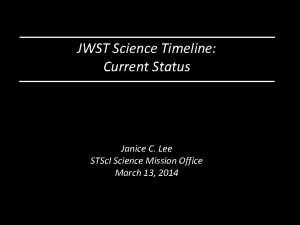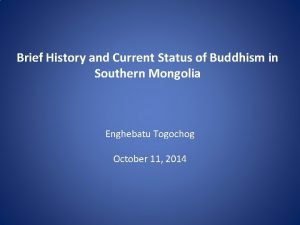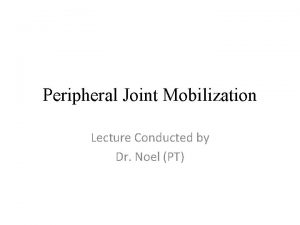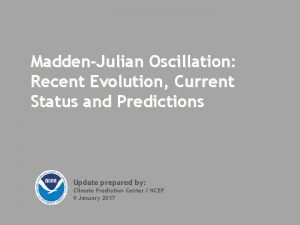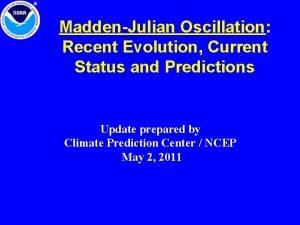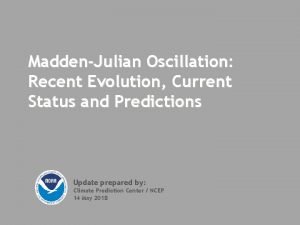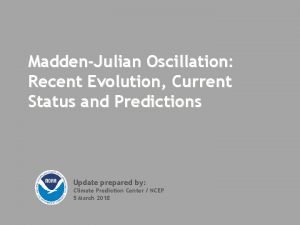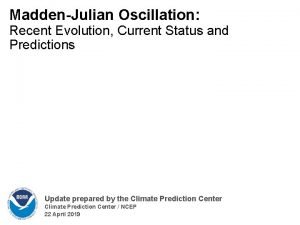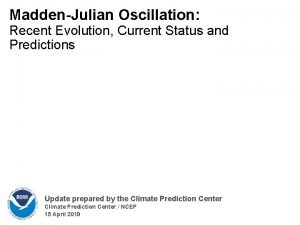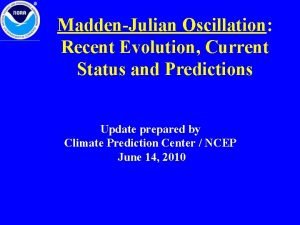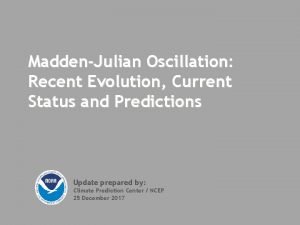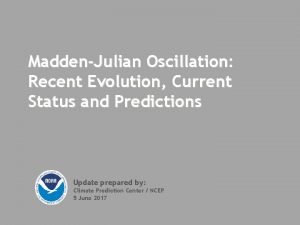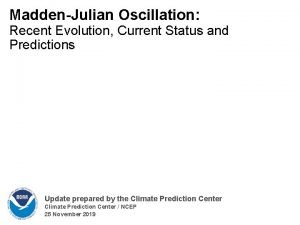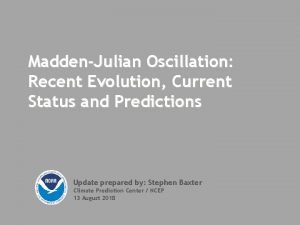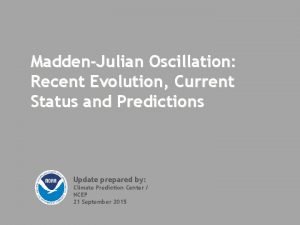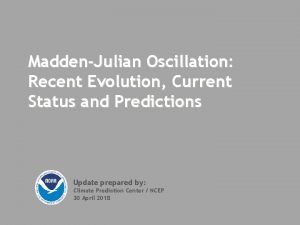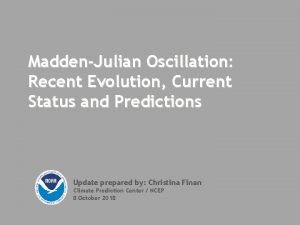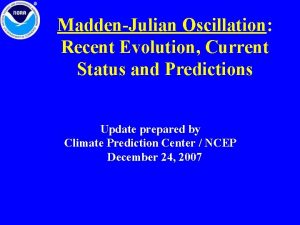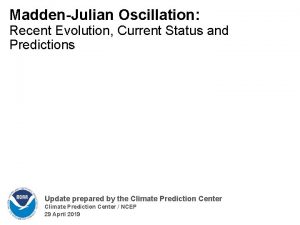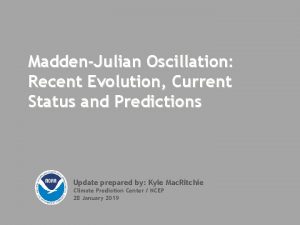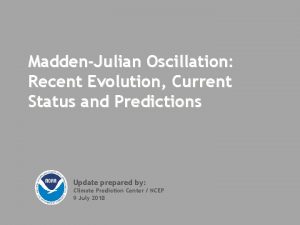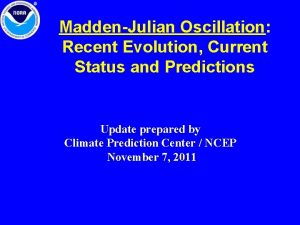MaddenJulian Oscillation Recent Evolution Current Status and Predictions





















- Slides: 21

Madden-Julian Oscillation: Recent Evolution, Current Status and Predictions Update prepared by: Climate Prediction Center / NCEP 15 February 2016

Outline Overview Recent Evolution and Current Conditions MJO Index Information MJO Index Forecasts MJO Composites

Overview The MJO has continued to become more organized based on various analysis tools, and the enhanced phase is centered over the far eastern Maritime Continent and West Pacific. Dynamical model forecasts of the RMM based MJO index generally support eastward propagation of a coherent signal across the Pacific basin. These tools also indicate interference with westward-moving variability during the next two weeks. Destructive interference between the intraseasonal signal and the ENSO background state reduces forecast confidence of convective anomalies early in the period. The ongoing and forecast MJO activity could impact the extratropical circulation during Weeks 2 -4, favoring anomalous troughing (ridging) across eastern North America (northwestern North America). Additional potential impacts across the global tropics and a discussion for the U. S. are available at: http: //www. cpc. ncep. noaa. gov/products/precip/CWlink/ghazards/index. php

850 -h. Pa Vector Wind Anomalies (m s-1) Note that shading denotes the zonal wind anomaly Blue shades: Easterly anomalies Red shades: Westerly anomalies intensified somewhat over the Indian Ocean, partly due to tropical cyclone activity south of the equator. Westerly anomalies weakened over the eastern Pacific and were replaced by easterly anomalies over much of the region.

850 -h. Pa Zonal Wind Anomalies (m s-1) Westerly anomalies (orange/red shading) represent anomalous west-to-east flow Easterly anomalies (blue shading) represent anomalous east-to-west flow The red box highlights the persistent lowfrequency westerly wind anomalies associated with ENSO. An eastward shift in the pattern was observed in late October, related to subseasonal activity. Renewed MJO activity during December produced an eastward propagation of westerly anomalies from the Indian Ocean. During early January, a strong westerly wind burst near the Date Line was related to constructive interference with the ongoing El Niño. The intraseasonal signal is imparting an eastward shift in the pattern of low-level wind anomalies, destructively interfering with the background state. .

OLR Anomalies – Past 30 days Drier-than-normal conditions, positive OLR anomalies (yellow/red shading) Wetter-than-normal conditions, negative OLR anomalies (blue shading) During mid-January, suppressed convection continued over the Maritime Continent and enhanced convection intensified over the Pacific, largely related to the ongoing the El Niño. By late January and early February, the pattern of tropical convection was largely consistent with ENSO. During early to mid-February, some destructive interference is observed, with enhanced convection spanning from the eastern Indian Ocean to the central Pacific. The intraseasonal variability competing with ENSO over the Maritime Continent led to a mixed signal there.

Outgoing Longwave Radiation (OLR) Anomalies (5ºN-5ºS) Drier-than-normal conditions, positive OLR anomalies (yellow/red shading) Wetter-than-normal conditions, negative OLR anomalies (blue shading) Since April, the ongoing El Niño is observed (red box) as a dipole of anomalous convection extending from the Maritime Continent to the East Pacific. During June and early July, the MJO became active, interfering with the ENSO signal at times. From August through October, other modes of subseasonal activity did impact tropical convection. During December, the MJO became active again, with the enhanced phase propagating from the Indian Ocean to the west-central Pacific during the month. During January, some destructive interference was observed, but recently eastward propagation of the MJO signal has nearly overwhelmed the suppressed ENSO signal over the Maritime Continent.

200 -h. Pa Velocity Potential Anomalies (5ºS - 5ºN) Positive anomalies (brown shading) indicate unfavorable conditions for precipitation Negative anomalies (green shading) indicate favorable conditions for precipitation The ongoing ENSO state is highlighted by the red box, showing anomalous divergence over the central and eastern Pacific. During June and early July, a high-amplitude MJO event was observed, constructively interfering with the El Niño signal in early July. From July through early October, a generally stationary pattern, reflective of El Niño conditions, was observed. During late October, there was an eastward shift in the pattern. Renewed MJO activity was observed during December and early January, yielding a robust signal in the upper levels. This signal weakened during mid-January as destructive interference with the El Niño background state increased. Recently, the pattern has begun to take on a wave-1 structure, consistent with coherent MJO activity.

IR Temperatures (K) / 200 -h. Pa Velocity Potential Anomalies The upper-level velocity potential anomalies now depict a wave-1 pattern, consistent with coherent MJO activity. The enhanced phase is centered over the West Pacific and far eastern Maritime Continent. Positive anomalies (brown contours) indicate unfavorable conditions for precipitation Negative anomalies (green contours) indicate favorable conditions for precipitation

200 -h. Pa Vector Wind Anomalies (m s-1) Note that shading denotes the zonal wind anomaly Blue shades: Easterly anomalies Red shades: Westerly anomalies An amplified wave pattern is evident during the recent period over the Pacific and North America domains. Notably, the canonical subtropical ridge associated with El Niño is not evident. A A

200 -h. Pa Zonal Wind Anomalies (m s-1) Westerly anomalies (orange/red shading) represent anomalous west-to-east flow Easterly anomalies (blue shading) represent anomalous east-to-west flow Easterly anomalies have persisted over the central and eastern Pacific since June associated with El Niño (red box). During late October, a temporary eastward shift in the westerly anomalies was evident across the Pacific. Eastward propagation of upper-level zonal wind anomalies was apparent over the Maritime Continent and West Pacific during late December and early January, consistent with MJO activity. More recently, westerly anomalies returned to near 120 E, while easterly anomalies persisted near the Date Line.

Weekly Heat Content Evolution in the Equatorial Pacific Oceanic Kelvin waves have alternating warm and cold phases. The warm phase is indicated by dashed lines. Downwelling and warming occur in the leading portion of a Kelvin wave, and upwelling and cooling occur in the trailing portion. Following a strong westerly wind burst in March, a strong downwelling phase of a Kelvin wave propagated eastward, reaching the South American coast during May. Reinforcing downwelling events have followed, resulting in persistently abovenormal heat content from the Date Line to 80 W throughout the period. An expansion of below average heat content over the western Pacific is evident since spring and this area has increased since November 2015. More recently, negative anomalies spread to east of the Date Line, while positive anomalies consolidated near 130 W.

MJO Index -- Information The MJO index illustrated on the next several slides is the CPC version of the Wheeler and Hendon index (2004, hereafter WH 2004). Wheeler M. and H. Hendon, 2004: An All-Season Real-Time Multivariate MJO Index: Development of an Index for Monitoring and Prediction, Monthly Weather Review, 132, 1917 -1932. The methodology is very similar to that described in WH 2004 but does not include the linear removal of ENSO variability associated with a sea surface temperature index. The methodology is consistent with that outlined by the U. S. CLIVAR MJO Working Group. Gottschalck et al. 2010: A Framework for Assessing Operational Madden-Julian Oscillation Forecasts: A CLIVAR MJO Working Group Project, Bull. Amer. Met. Soc. , 91, 1247 -1258. The index is based on a combined Empirical Orthogonal Function (EOF) analysis using fields of near-equatorially-averaged 850 -h. Pa and 200 -h. Pa zonal wind and outgoing longwave radiation (OLR).

MJO Index – Recent Evolution The axes (RMM 1 and RMM 2) represent daily values of the principal components from the two leading modes The triangular areas indicate the location of the enhanced phase of the MJO Counter-clockwise motion is indicative of eastward propagation. Large dot most recent observation. Distance from the origin is proportional to MJO strength Line colors distinguish different months The RMM based MJO index maintained amplitude over the past week, but began propagating eastward.

MJO Index – Historical Daily Time Series Time series of daily MJO index amplitude for the last few years. Plot puts current MJO activity in recent historical context.

Ensemble GFS (GEFS) MJO Forecast RMM 1 and RMM 2 values for the most recent 40 days and forecasts from the ensemble Global Forecast System (GEFS) for the next 15 days light gray shading: 90% of forecasts dark gray shading: 50% of forecasts The GFS ensemble MJO index forecast depicts a generally eastward propagation during the period. The forecast loop in Phase 6 is indicative of interference with westward-moving subseasonal variability. Yellow Lines – 20 Individual Members Green Line – Ensemble Mean

Ensemble GFS (GEFS) MJO Forecast Spatial map of OLR anomalies for the next 15 days The GEFS plot of MJO related OLR anomalies is unavailable at this time. The GEFS OLR forecast depicts eastward shifting negative (positive) OLR anomalies over the West Pacific (Indian Ocean). Constructive interference with the ENSO signal is possibly by late in the period. Figures below show MJO associated OLR anomalies only (reconstructed from RMM 1 and RMM 2) and do not include contributions from other modes (i. e. , ENSO, monsoons, etc. ) Time-longitude section of (7. 5°S-7. 5°N) OLR anomalies - last 180 days and for the next 15 days The GEFS plot of MJO related OLR anomalies is unavailable at this time.

Constructed Analog (CA) MJO Forecast Figures below show MJO associated OLR anomalies only (reconstructed from RMM 1 and RMM 2) and do not include contributions from other modes (i. e. , ENSO, monsoons, etc. ) Spatial map of OLR anomalies for the next 15 days Time-longitude section of (7. 5°S-7. 5°N) OLR anomalies - last 180 days and for the next 15 days The constructed analog model depicts eastward propagation of the MJO-associated OLR anomalies with gradually diminishing amplitude.

MJO Composites – Global Tropics 850 -h. Pa Velocity Potential and Wind Anomalies (Nov-Mar) Precipitation Anomalies (Nov-Mar)

U. S. MJO Composites – Temperature Left hand side plots show temperature anomalies by MJO phase for MJO events that have occurred over the three month period in the historical record. Blue (orange) shades show negative (positive) anomalies respectively. Right hand side plots show a measure of significance for the left hand side anomalies. Purple shades indicate areas in which the anomalies are significant at the 95% or better confidence level. Zhou et al. (2011): A composite study of the MJO influence on the surface air temperature and precipitation over the Continental United States, Climate Dynamics, 1 -13, doi: 10. 1007/s 00382 -011 -1001 -9 http: //www. cpc. ncep. noaa. gov/products/precip/CWlink/MJO/mjo. shtml

U. S. MJO Composites – Precipitation Left hand side plots show precipitation anomalies by MJO phase for MJO events that have occurred over the three month period in the historical record. Brown (green) shades show negative (positive) anomalies respectively. Right hand side plots show a measure of significance for the left hand side anomalies. Purple shades indicate areas in which the anomalies are significant at the 95% or better confidence level. Zhou et al. (2011): A composite study of the MJO influence on the surface air temperature and precipitation over the Continental United States, Climate Dynamics, 1 -13, doi: 10. 1007/s 00382 -011 -1001 -9 http: //www. cpc. ncep. noaa. gov/products/precip/CWlink/MJO/mjo. shtml
 A balanced delta connected load having an impedance 20-j15
A balanced delta connected load having an impedance 20-j15 Phase to phase voltage
Phase to phase voltage Drift current and diffusion current
Drift current and diffusion current Lesson 4 three-phase motors
Lesson 4 three-phase motors Drift current and diffusion current in semiconductor
Drift current and diffusion current in semiconductor Ceramic composition resistors
Ceramic composition resistors Balanced y-y connection
Balanced y-y connection Infineon
Infineon Diffusion current density
Diffusion current density Definition of size separation
Definition of size separation Gm formula for mosfet
Gm formula for mosfet A splice in a welding cable should never be any closer than
A splice in a welding cable should never be any closer than Touch current vs leakage current
Touch current vs leakage current Kcl mesh analysis
Kcl mesh analysis Current program status register is
Current program status register is Jwst current status
Jwst current status Current status of buddhism
Current status of buddhism Periodic motion examples images
Periodic motion examples images Indication and contraindication of mobilization
Indication and contraindication of mobilization Peripheral joint mobilization
Peripheral joint mobilization What is the amplitude of the oscillation
What is the amplitude of the oscillation Joint play definition
Joint play definition















